In Short:
Released in 2011 by Shaft, Puella Magi Madoka Magica is a delightful take on the popular Magical Girl genre of anime. In it, young middle schooler Madoka Kaname and her best friend Sayaka Miki are approached by a cute magical creature who offers to make a contract with them. It will grant each of them any single wish they desire, but in exchange they must defend their city against monster-like Witches. Although it can be a dangerous job, love and friendship are shown to be the keys to winning the day.
Some of the Witches, and the distorted magical labyrinths in which they reside, can appear fairly frightening at first in contrast to the abounding level of wholesomeness the rest of the show puts forth.
Suggested Watch Minimum: 3 episodes. Although Madoka Magica is highly reflective of past Magical Girl shows, it’s not until the end of the third episode that you get a full feel for where it is going and what makes it different from its predecessors.
Full Review:
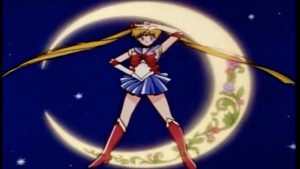 For myself and many others, the Magical Girl genre was how we were first introduced to anime. My first anime, whether or not I really knew it as anime back then, was the original 1992 English dub of Sailor Moon. In a Magical Girl anime, you typically have a clumsy or naive main character who comes in contact with a knowledgable mentor in the form of a cute magical animal. That mentor reveals that the main character is destined to have great hidden power or the ability to somehow fight evil if only they would unlock it. In a moment of crisis, the main character manages to transform in a flashy, highly detailed Henshin (Japanese for “transformation”) that usually gets repeated at least once per episode and uses their magical powers to defeat what is usually a monster or villain of the week. Making friends to fight along side and defeating evil are two of the most common aspects of Magical Girl shows.
For myself and many others, the Magical Girl genre was how we were first introduced to anime. My first anime, whether or not I really knew it as anime back then, was the original 1992 English dub of Sailor Moon. In a Magical Girl anime, you typically have a clumsy or naive main character who comes in contact with a knowledgable mentor in the form of a cute magical animal. That mentor reveals that the main character is destined to have great hidden power or the ability to somehow fight evil if only they would unlock it. In a moment of crisis, the main character manages to transform in a flashy, highly detailed Henshin (Japanese for “transformation”) that usually gets repeated at least once per episode and uses their magical powers to defeat what is usually a monster or villain of the week. Making friends to fight along side and defeating evil are two of the most common aspects of Magical Girl shows.
For Sailor Moon, the main character was Usagi Tsukino, a very clumsy and whiny middle school student who one day encounters Luna, a talking black cat. Luna reveals that Usagi is really Princess Serenity of the magical Moon Kingdom. With her true self revealed, Usagi is able to transform into the magical warrior Sailor Moon and fight to defend Earth against various evils along side other magical Sailor Scouts who soon become her friends.
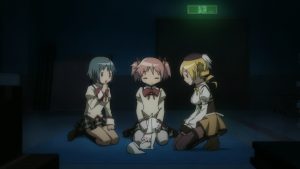 Released almost two decades later, Puella Magi Madoka Magica is a continuation of the Magical Girl genre first popularized by Sailor Moon. Our main hero, middle school student Madoka Kaname, is approached by the cute telepathic animal Kyubey who offers to make a contract with her. In exchange for helping to protect her city from “Witches”, hidden monsters who prey on ordinary people, Kyubey promises to grant Madoka any single wish she desires.
Released almost two decades later, Puella Magi Madoka Magica is a continuation of the Magical Girl genre first popularized by Sailor Moon. Our main hero, middle school student Madoka Kaname, is approached by the cute telepathic animal Kyubey who offers to make a contract with her. In exchange for helping to protect her city from “Witches”, hidden monsters who prey on ordinary people, Kyubey promises to grant Madoka any single wish she desires.
One of the things that makes Madoka Magica a worthwhile take on the genre, instead of a rehash of old ideas, is that Madoka does not become a magical girl by the end of the first episode as is so often the case with these type of shows. Instead, kind hearted Madoka and her friend Sayaka Miki, who has a strong sense of justice, hold back their wishes and team up with upper classman Mami Tomoe, their city’s most powerful Magical Girl, to see what it’s like to be a Magical Girl.
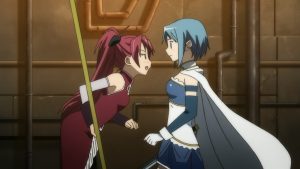 For the first few episodes, Mami explains to the two friends how being a Magical Girl is a great thing in that you get to save people and make the city safe. But Mami also touches on the more dangerous side of become a Magical Girl. That it’s not always fun and games, and that if you are going to exchange a single wish for the responsibility for keeping the city safe, you need to make sure your wish is a good one.
For the first few episodes, Mami explains to the two friends how being a Magical Girl is a great thing in that you get to save people and make the city safe. But Mami also touches on the more dangerous side of become a Magical Girl. That it’s not always fun and games, and that if you are going to exchange a single wish for the responsibility for keeping the city safe, you need to make sure your wish is a good one.
As the show progresses we also meet Kyoko Sakura, a more rowdy Magical Girl whose carefree attitude butts heads with Sayaka’s sense of justice. And we meet Homura Akemi, a cold, aloof Magical Girl who, for some reason, wants to keep Madoka from making her wish with Kyubey.
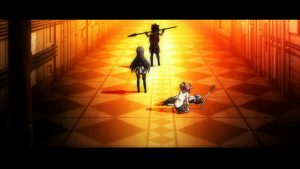 It’s these relationships and conflicts, all of which circle Madoka in one way or another, that really drive the show. In the end, it’s Madoka’s selfless sense of kindness that wins her friends over and saves the day. But along the way, there’s all sorts of great dialogue and outstanding character moments and some pretty interesting fights against the highly varied Witch monsters.
It’s these relationships and conflicts, all of which circle Madoka in one way or another, that really drive the show. In the end, it’s Madoka’s selfless sense of kindness that wins her friends over and saves the day. But along the way, there’s all sorts of great dialogue and outstanding character moments and some pretty interesting fights against the highly varied Witch monsters.
As a Magical Girl show, Madoka Magica wears its influences on its sleeve. From the cute episode opening and main theme, to the way Madoka wakes up in the morning, to the emphasis on the power of friendship, this show clearly knows the various tropes of the Magical Girl genre and hits on pretty much all of them. Even it’s main title graphic is highly reminiscent of past Magical Girl shows. But don’t let that fool you. Madoka Magica has a lot to offer even for someone who has seen past shows in the genre.
Graphics and Sound:
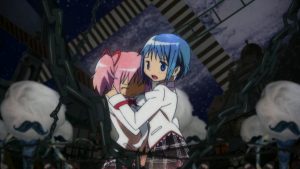 Though it doesn’t have the sharpest, most on-point animation, Madoka Magica still does a good job of getting its characters and situations across to the viewer. Though details can sometimes be a bit rough, the show manages to put forth a striking scene when it needs to. In particular, the show’s use of mixed media and stop motion animation for the Witches Labyrinths is particularly interesting and gives the fights against the otherworldly creatures an extra bit of creepiness. Artistically, the vision is there, but whether it was intentional or not, the actual animation in Madoka Magica is a bit… sloppy. I’d highly encourage you to track down the Blu-ray version of the show since many scenes received a fresh coat of paint and extra background details that make things feel more fleshed out and lived in.
Though it doesn’t have the sharpest, most on-point animation, Madoka Magica still does a good job of getting its characters and situations across to the viewer. Though details can sometimes be a bit rough, the show manages to put forth a striking scene when it needs to. In particular, the show’s use of mixed media and stop motion animation for the Witches Labyrinths is particularly interesting and gives the fights against the otherworldly creatures an extra bit of creepiness. Artistically, the vision is there, but whether it was intentional or not, the actual animation in Madoka Magica is a bit… sloppy. I’d highly encourage you to track down the Blu-ray version of the show since many scenes received a fresh coat of paint and extra background details that make things feel more fleshed out and lived in.
Soundwise, Madoka Magica is excellent. The song that plays alongside the opening is bouncy and delightful. And the general episode music has a nice flair to it. One of my favorite tracks, Credens justitiam, which plays during Mami’s first transformation sequence is a great cross between a latin hymn and an upbeat personification of the power of friendship and justice. Other tracks within the show do a great job of setting the mood, as well. The music in Madoka Magica is provided by top anime composer Yuki Kajiura and is some of her most outstanding work yet recorded.
Subtitles vs English dub can go either way. Both are very well done with great voice actors giving life to their characters. It really comes down to your own preference as to which one you listen to.
All In All:
Madoka Magica is a refined take on the Magical Girl genre that easily distinguishes itself from past series. It’s universal themes of friendship and justice are paired with enough wrinkles to keep things fresh and interesting. And it’s soundtrack is epic and memorable.
That’s all to say, there’s a reason Puella Magi Madoka Magica is well regarded as one of anime’s top Magical Girl shows.
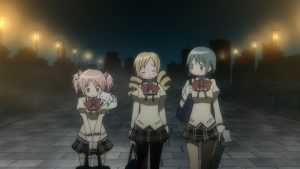 The reason Puella Magi Madoka Magica is well regarded as one of anime’s top Magical Girl shows isn’t actually its delightfulness or homages to the past. Instead, it owes much of its fame to much darker things. (If you haven’t watched up through episode 3 yet, stop and go do that before reading further.)
The reason Puella Magi Madoka Magica is well regarded as one of anime’s top Magical Girl shows isn’t actually its delightfulness or homages to the past. Instead, it owes much of its fame to much darker things. (If you haven’t watched up through episode 3 yet, stop and go do that before reading further.)
Fans of the Magical Girl genre will already be feeling that things aren’t quite right throughout the first three episodes. The emphasis on the tension of choosing a good wish. The warnings Mami gives about protecting the city as a Magical Girl not being fun. The feeling of impending doom that rises any time Homura appears. It all points to something being off the norms for the genre…
…and then at the end of episode 3, Mami is unceremoniously killed and eaten by a Witch she thought she had defeated!
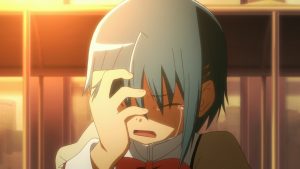 The shock that reverberated through the anime community by the end of the third episode is almost the stuff of legends. And, it’s something many of us who love the show try to preserve for newcomers as best we can. Going in thinking Madoka Magica is very nearly a typical, upbeat Magical Girl show only to slam into the episode 3 twist is something I’ve led friends into multiple times. And most of them loved it.
The shock that reverberated through the anime community by the end of the third episode is almost the stuff of legends. And, it’s something many of us who love the show try to preserve for newcomers as best we can. Going in thinking Madoka Magica is very nearly a typical, upbeat Magical Girl show only to slam into the episode 3 twist is something I’ve led friends into multiple times. And most of them loved it.
What at first seemed to be a delightful if somewhat out of the ordinary take on the Magical Girl formula is suddenly transformed into someone else entirely. Something darker. Something even more interesting. From episode 4 on, Madoka Magica concerns itself with what drives people to be Magical Girls, the perils of exchanging a single wish for a dangerous, unending responsibility, and what happens if your cute magical mascot is not the innocent benevolent creature it usually is in these kinds of shows.
In reality, Puella Magi Madoka Magica has two main strengths: Its characters, and the horrifyingly cruel situation they are put in by their supposed mentor and helper Kyubey.
 In most Magical Girl shows, the small magical mascot animals that first grants the girls their powers become one of the girls’ closest friends. They stay with their appointed girl during their daily routine. They are invisible to others giving the girl someone to talk to about the challenges of being a Magical Girl. And they are caring and highly protective of their Magical Girls, often going so far as to defend their charge as best they can if the going gets rough. Kyubey fulfills all of those aspects… except the last ones. Instead of caring about the Magical Girls it makes a contract with, Kyubey is at best indifferent to their fates. In reality, Kyubey actively leads the girls to disaster through both its actions and inactions.
In most Magical Girl shows, the small magical mascot animals that first grants the girls their powers become one of the girls’ closest friends. They stay with their appointed girl during their daily routine. They are invisible to others giving the girl someone to talk to about the challenges of being a Magical Girl. And they are caring and highly protective of their Magical Girls, often going so far as to defend their charge as best they can if the going gets rough. Kyubey fulfills all of those aspects… except the last ones. Instead of caring about the Magical Girls it makes a contract with, Kyubey is at best indifferent to their fates. In reality, Kyubey actively leads the girls to disaster through both its actions and inactions.
Mami Tomoe’s death early on is the first big twist of the show. It is a harsh wakeup call telling you that Madoka Magica won’t be like other, more wholesome Magical Girl shows. But, it’s not the last surprise the show has in store. Instead of Madoka Kaname becoming a Magical Girl and using the power of friendship and love to defeat evil, Puella Magi Madoka Magica is actually about preventing Madoka from making her contract with Kyubey in order to try and save her from the grotesque, horrifying fate that, by design, awaits all Magical Girls.
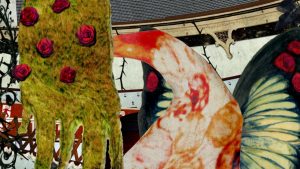 You see, Kyubey is actually a member of an alien race that call themselves Incubators. They are logical and emotionless and something of a hive mind to the point that they see human individuality and emotion as a sickness. They probably wouldn’t deal with us at all except they have a higher purpose. It’s their goal to save the universe from the restless force of entropy by harvesting an unending supply of energy from the Magical Girls that they create.
You see, Kyubey is actually a member of an alien race that call themselves Incubators. They are logical and emotionless and something of a hive mind to the point that they see human individuality and emotion as a sickness. They probably wouldn’t deal with us at all except they have a higher purpose. It’s their goal to save the universe from the restless force of entropy by harvesting an unending supply of energy from the Magical Girls that they create.
It turns out that the Witches that Mami and all other previous Magical Girls have been fighting have actually been the twisted forms of past Magical Girls who gave in to and were driven mad by their despair. Kyubey collects the energy generated by the transition from hope to despair without really caring about what it’s doing to the girls it makes a contract with.
 With that big reveal later in the series, suddenly all the efforts that Homura Akemi has taken to try and prevent Madoka from becoming a Magical Girl begin to make sense. Instead of a cold, uncaring person, Homura is shown to have become a Magical Girl expressly to save Madoka from her fate no matter how many tries it takes. Each time Homura fails, she travels back in time to try again and again and again. By the time the show starts, Homura has been stuck in this weeks long loop for over a hundred cycles. Her harsh, aloof attitude isn’t because she is uncaring, its because she cares so much that she has already exhausted every kinder, gentler approach to saving Madoka!
With that big reveal later in the series, suddenly all the efforts that Homura Akemi has taken to try and prevent Madoka from becoming a Magical Girl begin to make sense. Instead of a cold, uncaring person, Homura is shown to have become a Magical Girl expressly to save Madoka from her fate no matter how many tries it takes. Each time Homura fails, she travels back in time to try again and again and again. By the time the show starts, Homura has been stuck in this weeks long loop for over a hundred cycles. Her harsh, aloof attitude isn’t because she is uncaring, its because she cares so much that she has already exhausted every kinder, gentler approach to saving Madoka!
Along with Homura’s unending task are the tragic stories of Sayaka and Kyoko. The way these two first clash and later gain some sense of understanding of each other fleshes out the show so much. Sayaka’s initial sense of justice is understandably dashed when she finds out that she’s just being manipulated as a tool for a greater purpose. And, oddly enough, it’s the somewhat mean spirited, carefree, anything goes Kyoko that tries the hardest to save Sayaka from her downward spiral into despair.
 One of my favorite things about Madoka Magica is that its turn from delightful to cruelly tragic was all planned from before the beginning. All the teasers and trailers released for the series before it aired showed your typical candy-coated Magical Girl series. The initial ending theme for the first two episodes is light and happy only for the ending to be swapped out for a dark and ominous sequence by the third episode. Once you get far enough in to the show, even the lyrics to the opening song take on a new, darker meaning. Astonishingly, the production actually went so far as to hide the involvement of its co-creator and writer Gen Urobuchi from audiences since he was well known for going dark with his past works.
One of my favorite things about Madoka Magica is that its turn from delightful to cruelly tragic was all planned from before the beginning. All the teasers and trailers released for the series before it aired showed your typical candy-coated Magical Girl series. The initial ending theme for the first two episodes is light and happy only for the ending to be swapped out for a dark and ominous sequence by the third episode. Once you get far enough in to the show, even the lyrics to the opening song take on a new, darker meaning. Astonishingly, the production actually went so far as to hide the involvement of its co-creator and writer Gen Urobuchi from audiences since he was well known for going dark with his past works.
This purposeful deception on the part of the show’s creators, combined with the legitimately awesome story and characters are the real reason that Puella Magi Madoka Magica is held up as one of the best of the Magical Girl genre. This is one of those shows that doesn’t waste a moment. Every episode matters. Every action the characters take is important. But, maybe the best thing that the show does is that after all the grief and suffering it puts its characters through, it still remembers what it means to be a true, ideal version of a Magical Girl. It’s right there in the title. Magical Girl Madoka Magica. It turns out that the show wasn’t all one big elaborate lie. It just takes its sweet, delicious time building up to the things it initially promised. By the end of the series, Madoka finally makes her wish with Kyubey and becomes a Magical Girl. With the full knowledge of all the terrible things that came before, Madoka is able to make a perfect wish and embody the true spirit of a classic Magical Girl in breathtaking fashion.
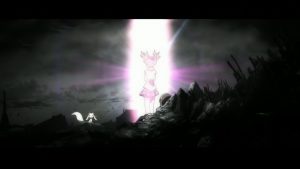 It’s this great moment where the series loops back on itself. After having shown just how horrible it is to trick young girls into fighting and dying and giving in to despair, the series is able to show us that the power of love and friendship and selflessness can win the day. The writing and pacing skills it took to pull that off along with a major time travel plot and along with multiple big, jaw dropping twists is truly remarkable. Because of all that, I’m of the opinion that Puella Magi Madoka Magica has one of the best stories and perhaps the best, most well supported, most perfect ending of any anime out there…
It’s this great moment where the series loops back on itself. After having shown just how horrible it is to trick young girls into fighting and dying and giving in to despair, the series is able to show us that the power of love and friendship and selflessness can win the day. The writing and pacing skills it took to pull that off along with a major time travel plot and along with multiple big, jaw dropping twists is truly remarkable. Because of all that, I’m of the opinion that Puella Magi Madoka Magica has one of the best stories and perhaps the best, most well supported, most perfect ending of any anime out there…
…which is gonna make things a bit awkward when we talk about the follow up movie, Rebellion.